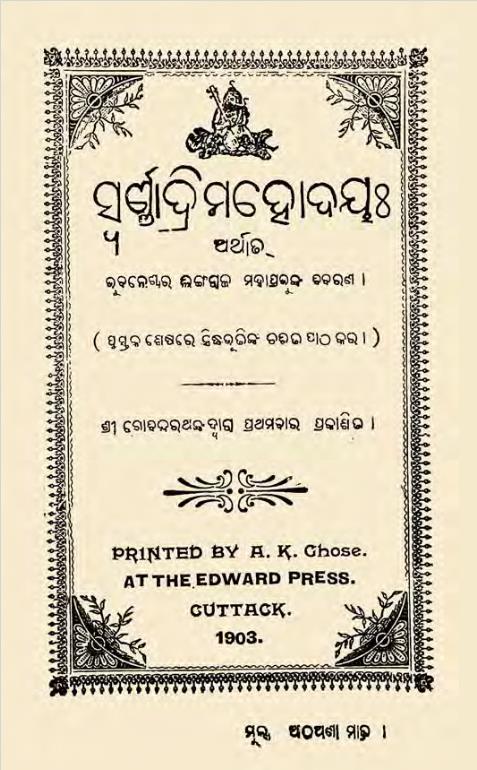In the realm of Odia literature, the year 1903 marks a significant milestone with the publication of Swarnadrimahodayah,a poetic masterpiece that resonates deeply with the cultural and spiritual ethos of Odisha. The collection, known for its profound themes and elegant style, is a landmark in the revival of Odia poetry and serves as a testament to the rich literary heritage of the region.
At the heart of Swarnadrimahodayah is its exploration of divinity and nature, interwoven with the essence of Odisha’s cultural identity. One can discern threads of traditional Odia philosophical thought, infused with elements of spiritual longing and existential inquiry. Each poem encapsulates a unique narrative, often drawing inspiration from the local landscape, mythology, and the everyday lives of people. This blend of the sublime and the mundane creates a tapestry that is at once relatable and transcendent.
A notable sub-poem within Swarnadrimahodayah is dedicated to Lingaraj, the presiding deity of the Lingaraj Temple in Bhubaneswar. Through evocative imagery and lyrical language, the poet paints a vivid picture of this sacred site, illustrating not only its architectural grandeur but also its spiritual significance. Lingaraj, a manifestation of Lord Shiva, embodies the convergence of time and eternity, the mortal and the divine. The poet captures the palpable devotion of the pilgrims who flock to the temple, immersing readers in a reverence that transcends the written word.
Another captivating aspect of the collection is its embrace of Ekamra, a historical region in Odisha often associated with Lord Shiva. The poetic depictions of Ekamra are imbued with a sense of nostalgia and gratitude, showcasing the connection between the land and its people. The poet employs rich metaphors to highlight the beauty of the landscape, drawing parallels between the natural world and the divine presence. The lush greenery, flowing rivers, and serene environment serve as a backdrop that enhances the spiritual experience of the devotees, echoing the philosophy that nature and divinity are intricately intertwined.
Swarnadrimahodayah also delves into the realm of Sanskrit, reflecting the linguistic richness that has influenced Odia poetry. The poet often weaves Sanskrit words and phrases into the verses, elevating the text’s scholarly appeal while retaining its accessibility for the common reader. This interplay between the two languages not only enriches the poetic structure but also honors the historical ties of Odia with its classical roots.
Moreover, the collection is significant in its context within the early 20th-century Odisha, a period marked by a resurgence of interest in regional identity and cultural pride. The themes of spirituality, nature, and devotion mirrored societal aspirations, as Odia intellectuals sought to reclaim their heritage against the backdrop of colonial rule.
Books Info
| Books name | Swarnadrimahodayah / ସ୍ୱର୍ଣ୍ଣାଦ୍ରିମହୋଦୟଃ |
| Author | NA |
| No Of pages | 158 |
| Publisher | NA |
| Publication | 1903 |
| Printed At | The Edward Press |
| Distributor | NA |

